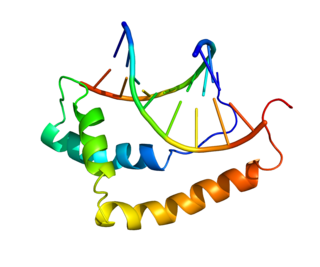
Sex-determining region Y protein (SRY), or testis-determining factor (TDF), is a DNA-binding protein encoded by the SRY gene that is responsible for the initiation of male sex determination in therian mammals. SRY is an intronless sex-determining gene on the Y chromosome. Mutations in this gene lead to a range of disorders of sex development with varying effects on an individual's phenotype and genotype.
SOX genes encode a family of transcription factors that bind to the minor groove in DNA, and belong to a super-family of genes characterized by a homologous sequence called the HMG-box. This HMG box is a DNA binding domain that is highly conserved throughout eukaryotic species. Homologues have been identified in insects, nematodes, amphibians, reptiles, birds and a range of mammals. However, HMG boxes can be very diverse in nature, with only a few amino acids being conserved between species.

Paired box protein Pax-6, also known as aniridia type II protein (AN2) or oculorhombin, is a protein that in humans is encoded by the PAX6 gene.

The steroidogenic factor 1 (SF-1) protein is a transcription factor involved in sex determination by controlling the activity of genes related to the reproductive glands or gonads and adrenal glands. This protein is encoded by the NR5A1 gene, a member of the nuclear receptor subfamily, located on the long arm of chromosome 9 at position 33.3. It was originally identified as a regulator of genes encoding cytochrome P450 steroid hydroxylases, however, further roles in endocrine function have since been discovered.

DAX1 is a nuclear receptor protein that in humans is encoded by the NR0B1 gene. The NR0B1 gene is located on the short (p) arm of the X chromosome between bands Xp21.3 and Xp21.2, from base pair 30,082,120 to base pair 30,087,136.

SRY -box 2, also known as SOX2, is a transcription factor that is essential for maintaining self-renewal, or pluripotency, of undifferentiated embryonic stem cells. Sox2 has a critical role in maintenance of embryonic and neural stem cells.

Transcription factor SOX-9 is a protein that in humans is encoded by the SOX9 gene.

Transcription factor SOX-4 is a protein that in humans is encoded by the SOX4 gene.

Transcription factor SOX-5 is a protein that in humans is encoded by the SOX5 gene.

Homeobox protein OTX2 is a protein that in humans is encoded by the OTX2 gene.

Transcription factor SOX-13 is a protein that in humans is encoded by the SOX13 gene.

Transcription factor SOX-18 is a protein that in humans is encoded by the SOX18 gene.

Transcription factor SOX-11 is a protein that in humans is encoded by the SOX11 gene.

Transcription factor SOX-8 is a protein that in humans is encoded by the SOX8 gene.

Protein SOX-15 is a protein that in humans is encoded by the SOX15 gene.

SOX12 is a protein that in humans is encoded by the SOX12 gene. Sox12 belongs to the SoxC group of Sox family of transcription factors, together with Sox4 and Sox11. Sox12-null knockout mice appear normal, unlike Sox4 or Sox11 knockout mice. This probably comes from functional redundancy with Sox4 and Sox11. Sox12 is a weaker activator than both Sox4 and Sox11 in mouse.

Transcription factor SOX-14 is a protein that in humans is encoded by the SOX14 gene.

Transcription factor SOX-21 is a protein that in humans is encoded by the SOX21 gene. It is a member of the Sox gene family of transcription factors.

SOX1 is a gene that encodes a transcription factor with a HMG-box DNA-binding domain and functions primarily in neurogenesis. SOX1, SOX2 and SOX3, members of the SOX gene family, contain transcription factors related to SRY, the testis-determining factor.
Peter Anthony Koopman is an Australian biologist best known for his role in the discovery and study of the mammalian Y-chromosomal sex-determining gene, Sry.




















